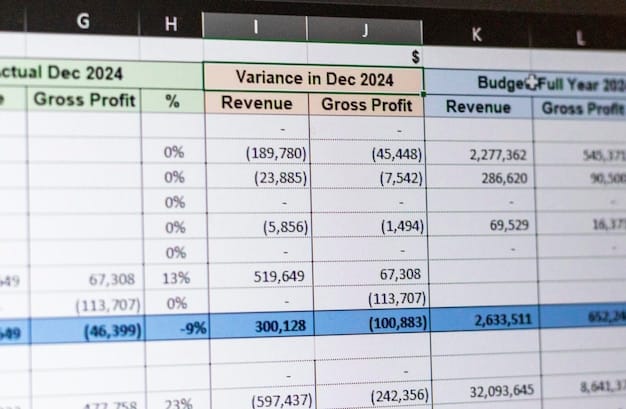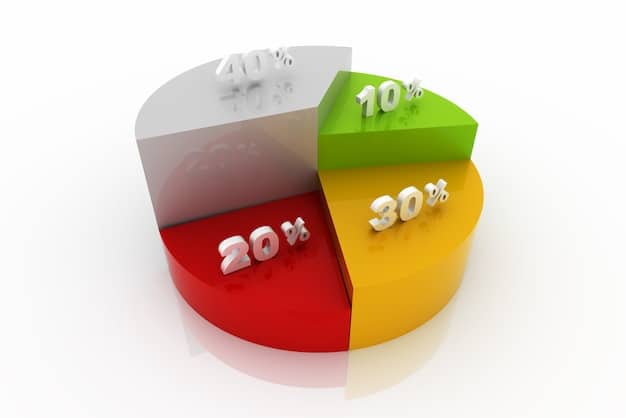Realistic Budgeting 2025: A Step-by-Step Guide That Works

Creating a realistic budget that actually works in 2025 involves assessing your income, tracking expenses, setting financial goals, and making adjustments to ensure long-term financial stability.
Ready to take control of your finances? Discover how to create a realistic budget that actually works: a step-by-step guide for 2025 and achieve your financial goals with confidence.
Understanding Your Financial Landscape
Before diving into the specifics of budgeting, it’s crucial to understand your current financial situation. This involves assessing your income, expenses, assets, and liabilities. Taking the time to understand these elements will give you a solid foundation upon which to build a realistic budget.
Calculating Your Income
Start by determining your total income. This includes your salary, wages, any side hustle income, and income from investments. Be sure to calculate your after-tax income to get a clear picture of what you actually have available.
Identifying Your Expenses
Next, track your expenses for at least a month. You can use budgeting apps, spreadsheets, or even a notebook to record every dollar you spend. Categorize your expenses into fixed (e.g., rent, mortgage, insurance) and variable (e.g., groceries, entertainment, dining out) to get a better understanding of where your money is going.

Here are some helpful tips for identifying your expenses:
- Use budgeting apps to automate expense tracking.
- Review your bank and credit card statements regularly.
- Categorize your spending to identify areas where you can cut back.
Understanding your financial landscape is the first step toward creating a budget that truly reflects your lifestyle and financial goals. With a clear picture of your income and expenses, you can move on to setting realistic financial goals.
Setting Clear Financial Goals
Setting financial goals is an essential part of creating a budget that works. Without clear objectives, it’s easy to lose motivation and stray from your budget. Make sure your goals are specific, measurable, achievable, relevant, and time-bound (SMART).
Short-Term Goals
Short-term goals are those you want to achieve within a year. These might include saving for a vacation, paying off a small debt, or building an emergency fund.
Long-Term Goals
Long-term goals are those that take more than a year to achieve. Examples include buying a home, saving for retirement, or paying off student loans.
Here are some examples of SMART financial goals:
- Save $5,000 for an emergency fund within 12 months.
- Pay off a $2,000 credit card debt in 6 months.
- Save $10,000 for a down payment on a house in 3 years.
With clear financial goals in mind, you can tailor your budget to prioritize those objectives. This will make your budgeting efforts more focused and effective, helping you stay on track and make progress toward your dreams.
Choosing the Right Budgeting Method
There are several budgeting methods you can use, each with its own advantages and disadvantages. Choosing the right method depends on your personality, financial situation, and goals. Here are a few popular budgeting methods to consider.
The 50/30/20 Rule
The 50/30/20 rule allocates 50% of your income to needs, 30% to wants, and 20% to savings and debt repayment. This simple approach can be a good starting point for beginners.
Zero-Based Budgeting
Zero-based budgeting requires you to allocate every dollar of your income to a specific category. The goal is to have a net zero balance at the end of the month, ensuring that every dollar is accounted for.
Envelope Budgeting
Envelope budgeting involves using cash-filled envelopes for different spending categories, such as groceries, entertainment, and dining out. Once the cash in an envelope is gone, you can’t spend any more in that category until the next month.

Consider these factors when choosing a budgeting method:
- Your income and expenses
- Your financial goals
- Your personality and spending habits
Selecting the right budgeting method can make a significant difference in your ability to stick to your budget and achieve your financial goals. Experiment with different approaches to find what works best for you.
Tracking Your Spending Habits
Tracking your spending habits is crucial for maintaining a realistic budget. It allows you to monitor your progress, identify areas where you can cut back, and make adjustments to your budget as needed. There are several tools and techniques you can use to track your spending.
Budgeting Apps
Budgeting apps like Mint, YNAB (You Need a Budget), and Personal Capital can automatically track your spending and provide insights into your financial habits.
Spreadsheets
Creating a spreadsheet is a simple and customizable way to track your spending. You can create categories for different expenses and manually enter your transactions.
Manual Tracking
If you prefer a more hands-on approach, you can track your spending using a notebook or a physical ledger. This can be a good way to stay mindful of your spending.
Here are some tips for effective spending tracking:
- Record every transaction, no matter how small.
- Categorize your expenses to identify spending patterns.
- Review your spending regularly to stay on track.
Tracking your spending habits is an ongoing process that requires discipline and attention to detail. By staying vigilant and making adjustments as needed, you can ensure that your budget remains realistic and effective over time.
Making Adjustments and Staying Flexible
A budget is not a static document; it’s a living plan that should evolve with your changing circumstances. Life is unpredictable, and unexpected expenses or changes in income can throw your budget off course. That’s why it’s important to stay flexible and make adjustments as needed.
Regularly Review Your Budget
Set aside time each month to review your budget and track your progress toward your financial goals. This will help you identify areas where you’re on track and areas where you need to make adjustments.
Adjust for Unexpected Expenses
If you encounter unexpected expenses, such as a car repair or a medical bill, don’t panic. Look for ways to cut back on other expenses or dip into your emergency fund to cover the cost.
Consider these strategies for staying flexible with your budget:
- Build a buffer into your budget for unexpected expenses.
- Be willing to adjust your spending habits as needed.
- Don’t be afraid to seek advice from a financial advisor.
Making adjustments and staying flexible is essential for long-term budgeting success. By adapting to change and remaining committed to your financial goals, you can stay on track and achieve your dreams.
Automating Your Savings and Investments
Automating your savings and investments is a powerful way to build wealth and achieve your financial goals. By setting up automatic transfers from your checking account to your savings or investment accounts, you can make saving a seamless and effortless part of your routine.
Set Up Automatic Transfers
Arrange for a portion of your paycheck to be automatically transferred to your savings account or investment account each month. This ensures that you’re consistently saving money without having to think about it.
Take Advantage of Employer-Sponsored Retirement Plans
If your employer offers a 401(k) or other retirement plan, take advantage of it. Contribute enough to get the full employer match, which is essentially free money.
Here are some additional benefits of automating your savings and investments:
- It eliminates the temptation to spend your savings.
- It helps you stay on track with your financial goals.
- It makes saving a habit.
Automating your savings and investments is a smart way to build wealth over time. By making saving a priority and automating the process, you can set yourself up for long-term financial security.
| Key Point | Brief Description |
|---|---|
| 💰 Income Assessment | Calculate total after-tax income from all sources. |
| 📊 Expense Tracking | Monitor expenses using apps, spreadsheets, or notebooks to categorize them. |
| 🎯 SMART Goals | Set Specific, Measurable, Achievable, Relevant, Time-bound goals. |
| 🔄 Budget Flexibility | Adapt to income changes and unexpected expenses by reviewing and adjusting regularly. |
Frequently Asked Questions
▼
The first step is to assess your current financial situation by calculating your income and tracking your expenses. This will give you a clear picture of where your money is coming from and where it is going.
▼
You should review your budget at least once a month to ensure that you are on track with your financial goals. This will also allow you to make any necessary adjustments based on changes in your income or expenses.
▼
If you have unexpected expenses, try to cut back on other areas of your budget or use your emergency fund to cover the cost. It’s important to stay flexible and make adjustments as needed.
▼
The 50/30/20 rule is a budgeting method that allocates 50% of your income to needs, 30% to wants, and 20% to savings and debt repayment. It’s a simple way to manage your finances without complex tracking.
▼
You can automate your savings by setting up automatic transfers from your checking account to your savings or investment accounts. This ensures that you consistently save money without having to actively think about it.
Conclusion
Creating a realistic budget that works is a journey that requires understanding your financial landscape, setting clear goals, and choosing the right budgeting method. By consistently tracking your spending, making necessary adjustments, and automating your savings, you can achieve financial stability and reach your long-term goals. Remember to stay flexible and adapt your budget as your circumstances change, ensuring a financially secure future.





